A Look at Antique Coffee Grinders
by Maxine Carter-Lome
There is nothing like the smell and taste of freshly ground coffee. Today, coffee consumers have the choice of buying pre-packaged ground coffee or beans by the pound to be freshly ground at home. This was not the case for most of rural America in the 19th century when beans were purchased and ground on-site at the general store.
While methods for grinding the coffee bean date back centuries, American inventors were late to the party compared to their European counterparts. The first U.S. patent for a coffee mill—also referred to as a coffee grinder—was issued in 1798 to Thomas Bruff of Maryland. Bruff was a self-described inventor whose other claim to fame was serving as Thomas Jefferson’s dentist. He wrote to Jefferson in 1801 about his invention: “Sir, … Nature has designed me for inventing … a coffee mill, that grinds a pound in 4 & 1/2 minutes…” His wall-mounted device ground beans between metal nuts with coarse and fine teeth, a design popularized by companies throughout the 19th and early 20th century. Many of these wall-mounted grinders were made of brass or cast iron and featured a clear glass hopper at the top to hold beans to be ground – as much as a pound or more. The big crank handle on the side would be turned to start the grinding, and a wooden drawer at the base would collect the ground coffee. Over time this utilitarian device became more decorative and ornate. Today, wall-mounted grinders are considered the more popular version for collectors.
One of the most popular coffee mills for grinding larger amounts of coffee in the general store was the Enterprise Model No. 12-1/2. Manufactured between 1886 and 1898, it stood 42 inches high, had 25-inch diameter wheels and weighed about 140 pounds. Its main components were made of cast iron. Such mills became status symbols for those general store owners who could afford them. Its value now is well over $1,000.
Today, wall-mounted, box-shaped, table-mounted, one-wheel, and two-wheel mills and other types of commercial and household grinders from the 19th and the first half of the 20th century, are all highly collectible and run the gamut from rustic to highly ornate and decorative. Even at their most primitive, collectors value them for their design, history, and quality of craftsmanship.
Collecting Tips
It’s important to know who and what to look for when viewing the number of different types and sizes of American-made antique coffee mills and grinders found online and at shows and markets – this can be an expensive collecting hobby. There are many reproductions on the market and it is often buyer-beware when making a purchase. Here are a few manufacturers to know:
The Arcade Manufacturing Co. of Freeport, Illinois is known for its canister-type, wall-mounted coffee mills. The Arcade No. 3 is its most iconic model.
The mill itself was cast iron but the canister that held the coffee beans on top of the mill was clear glass. A second much smaller glass container caught the ground coffee at the bottom of the mill. Because these glass canisters were easily broken and not the nearly indestructible as a cast iron base, inspect the glass and speak with the dealer to learn whether it is original to the piece or a reproduction created to look like the original.
The Enterprise Manufacturing Company, founded in Philadelphia in 1864, was one of the leading makers of both large and small coffee grinders. Enterprise made heavy-duty grinders for grocers, retailers, and wholesalers. While many of these wall or table-mounted machines had side crank handles, its largest grinders had handles that attached to flywheels. Enterprise made one- and two-wheel grinders. The most ornate examples were made in the late 19th and early 20th centuries with eagle finials atop the urn-shaped hoppers and a pair of flywheels. These more industrialized versions would be mounted on a waist-high, decorative, cast-iron stand.
Landers Frary and Clark of New Britain, Connecticut began coffee grinder production in the mid-1870s and made mills of all kinds: box, side, wall canisters, two-wheelers, and electric. Of note: a tin canister wall mill introduced in the late 1890s that was cost effective to build. Also, a series of cast iron coffee mills were made and patterned after those made by Enterprise Mfg. Co. They were introduced around the turn of the century and featured a unique six-spoke design on the double-wheel models.
Other notable American manufacturers include Logan and Strobridge, The Charles Parker Co., Steinfeld, Wilmont Castle, and Wrightsville Hardware Company.
Google “antique coffee grinders” and dozens of websites pop up, from eBay to Pinterest (for beauty shots), Etsy (for restoration and reproduction projects), collector sites, and auction houses. Once valued for their intended purpose, today they are collected and valued for their design, size, raw materials, maker, craftsmanship, adornment, embossing, paint, patina, and condition. Design and embellishments have allowed coffee grinders to be viewed as pieces of art, and increasingly valued as such; however, more so at shows and markets than the prices realized at auctions. With a few notable exceptions, you can expect to pay around $60-$150 for an early, primitive, well-used example of a box-shaped, wall-hung, and table-mounted grinder as compared to a few hundred more for a nice, well-made and decorative free-standing one-wheel or two-wheel grinder. Larger-size wheel grinders from particular companies, and those that have been restored, can fetch several thousand.
There are a number of YouTube channels dedicated to the restoration of cast iron objects including coffee grinders. This typically includes stripping them down to their metal, bringing them back to working order, and giving them a new coat of paint. The result is a working, decorative display piece that is now valued as art and as a piece of history – an object of everyday life, then and now.

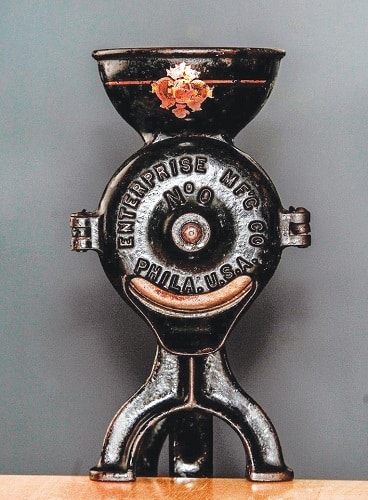
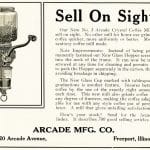
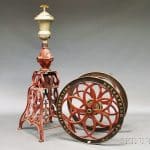
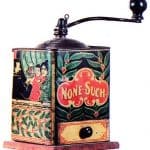

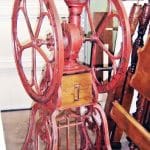
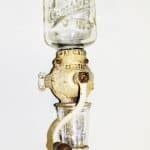
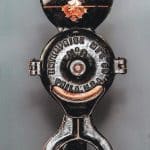



Related posts: